In-depth Analysis: Aetiology, Control & Impact of Oral Diseases
VerifiedAdded on 2023/06/13
|17
|4004
|182
Homework Assignment
AI Summary
This assignment provides a detailed overview of oral diseases, focusing on plaque, caries, and periodontal disease. It describes plaque formation, its constituents, and methods for control, including brushing and chemical plaque control. The aetiology of caries is discussed, emphasizing the role of oral microorganisms and dietary carbohydrates. The assignment also explores the aetiology of periodontal disease, highlighting factors like diabetes, stress, smoking, and hormonal changes. Furthermore, it examines pH levels in the mouth, critical levels for demineralisation and remineralisation, and the impact of aging on the oral cavity. The solution includes a discussion on the signs, symptoms, and treatments for inflammation, as well as causative factors and treatments for abrasion, attrition, and erosion. This document is available on Desklib, where students can find a variety of solved assignments and study resources.

DN8.
Paraphrase This Document
Need a fresh take? Get an instant paraphrase of this document with our AI Paraphraser
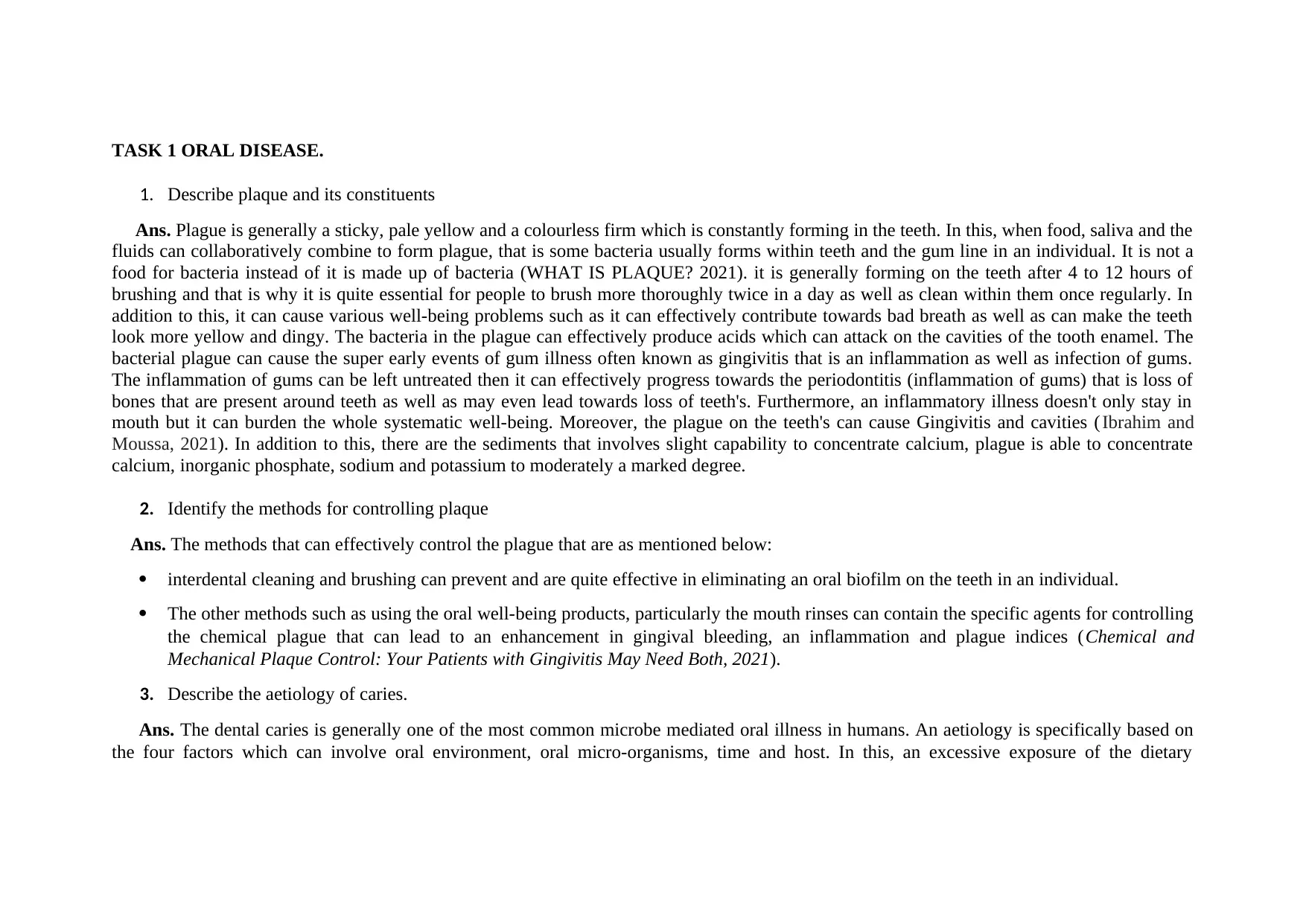
TASK 1 ORAL DISEASE.
1. Describe plaque and its constituents
Ans. Plague is generally a sticky, pale yellow and a colourless firm which is constantly forming in the teeth. In this, when food, saliva and the
fluids can collaboratively combine to form plague, that is some bacteria usually forms within teeth and the gum line in an individual. It is not a
food for bacteria instead of it is made up of bacteria (WHAT IS PLAQUE? 2021). it is generally forming on the teeth after 4 to 12 hours of
brushing and that is why it is quite essential for people to brush more thoroughly twice in a day as well as clean within them once regularly. In
addition to this, it can cause various well-being problems such as it can effectively contribute towards bad breath as well as can make the teeth
look more yellow and dingy. The bacteria in the plague can effectively produce acids which can attack on the cavities of the tooth enamel. The
bacterial plague can cause the super early events of gum illness often known as gingivitis that is an inflammation as well as infection of gums.
The inflammation of gums can be left untreated then it can effectively progress towards the periodontitis (inflammation of gums) that is loss of
bones that are present around teeth as well as may even lead towards loss of teeth's. Furthermore, an inflammatory illness doesn't only stay in
mouth but it can burden the whole systematic well-being. Moreover, the plague on the teeth's can cause Gingivitis and cavities ( Ibrahim and
Moussa, 2021). In addition to this, there are the sediments that involves slight capability to concentrate calcium, plague is able to concentrate
calcium, inorganic phosphate, sodium and potassium to moderately a marked degree.
2. Identify the methods for controlling plaque
Ans. The methods that can effectively control the plague that are as mentioned below:
interdental cleaning and brushing can prevent and are quite effective in eliminating an oral biofilm on the teeth in an individual.
The other methods such as using the oral well-being products, particularly the mouth rinses can contain the specific agents for controlling
the chemical plague that can lead to an enhancement in gingival bleeding, an inflammation and plague indices (Chemical and
Mechanical Plaque Control: Your Patients with Gingivitis May Need Both, 2021).
3. Describe the aetiology of caries.
Ans. The dental caries is generally one of the most common microbe mediated oral illness in humans. An aetiology is specifically based on
the four factors which can involve oral environment, oral micro-organisms, time and host. In this, an excessive exposure of the dietary
1. Describe plaque and its constituents
Ans. Plague is generally a sticky, pale yellow and a colourless firm which is constantly forming in the teeth. In this, when food, saliva and the
fluids can collaboratively combine to form plague, that is some bacteria usually forms within teeth and the gum line in an individual. It is not a
food for bacteria instead of it is made up of bacteria (WHAT IS PLAQUE? 2021). it is generally forming on the teeth after 4 to 12 hours of
brushing and that is why it is quite essential for people to brush more thoroughly twice in a day as well as clean within them once regularly. In
addition to this, it can cause various well-being problems such as it can effectively contribute towards bad breath as well as can make the teeth
look more yellow and dingy. The bacteria in the plague can effectively produce acids which can attack on the cavities of the tooth enamel. The
bacterial plague can cause the super early events of gum illness often known as gingivitis that is an inflammation as well as infection of gums.
The inflammation of gums can be left untreated then it can effectively progress towards the periodontitis (inflammation of gums) that is loss of
bones that are present around teeth as well as may even lead towards loss of teeth's. Furthermore, an inflammatory illness doesn't only stay in
mouth but it can burden the whole systematic well-being. Moreover, the plague on the teeth's can cause Gingivitis and cavities ( Ibrahim and
Moussa, 2021). In addition to this, there are the sediments that involves slight capability to concentrate calcium, plague is able to concentrate
calcium, inorganic phosphate, sodium and potassium to moderately a marked degree.
2. Identify the methods for controlling plaque
Ans. The methods that can effectively control the plague that are as mentioned below:
interdental cleaning and brushing can prevent and are quite effective in eliminating an oral biofilm on the teeth in an individual.
The other methods such as using the oral well-being products, particularly the mouth rinses can contain the specific agents for controlling
the chemical plague that can lead to an enhancement in gingival bleeding, an inflammation and plague indices (Chemical and
Mechanical Plaque Control: Your Patients with Gingivitis May Need Both, 2021).
3. Describe the aetiology of caries.
Ans. The dental caries is generally one of the most common microbe mediated oral illness in humans. An aetiology is specifically based on
the four factors which can involve oral environment, oral micro-organisms, time and host. In this, an excessive exposure of the dietary
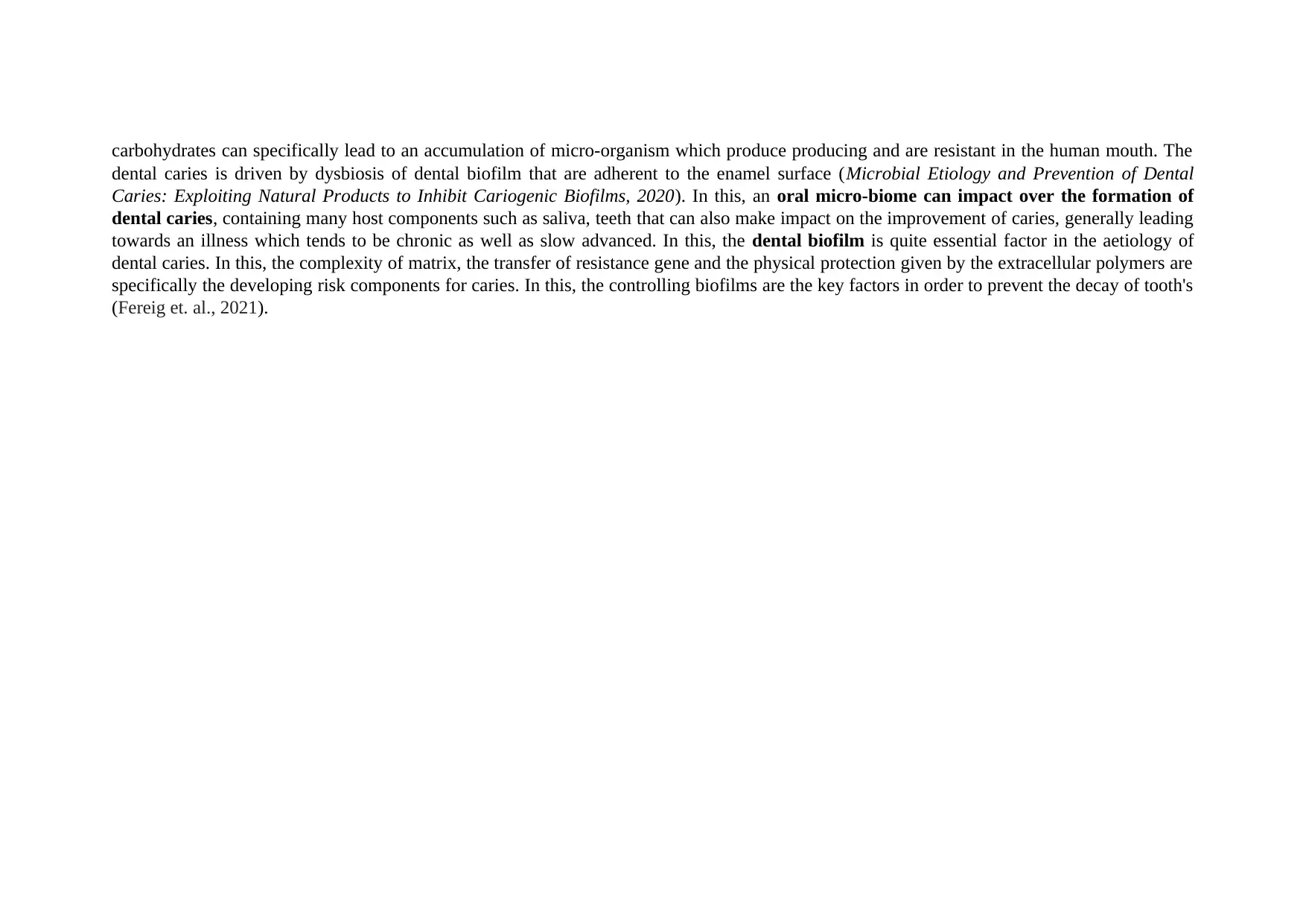
carbohydrates can specifically lead to an accumulation of micro-organism which produce producing and are resistant in the human mouth. The
dental caries is driven by dysbiosis of dental biofilm that are adherent to the enamel surface (Microbial Etiology and Prevention of Dental
Caries: Exploiting Natural Products to Inhibit Cariogenic Biofilms, 2020). In this, an oral micro-biome can impact over the formation of
dental caries, containing many host components such as saliva, teeth that can also make impact on the improvement of caries, generally leading
towards an illness which tends to be chronic as well as slow advanced. In this, the dental biofilm is quite essential factor in the aetiology of
dental caries. In this, the complexity of matrix, the transfer of resistance gene and the physical protection given by the extracellular polymers are
specifically the developing risk components for caries. In this, the controlling biofilms are the key factors in order to prevent the decay of tooth's
(Fereig et. al., 2021).
dental caries is driven by dysbiosis of dental biofilm that are adherent to the enamel surface (Microbial Etiology and Prevention of Dental
Caries: Exploiting Natural Products to Inhibit Cariogenic Biofilms, 2020). In this, an oral micro-biome can impact over the formation of
dental caries, containing many host components such as saliva, teeth that can also make impact on the improvement of caries, generally leading
towards an illness which tends to be chronic as well as slow advanced. In this, the dental biofilm is quite essential factor in the aetiology of
dental caries. In this, the complexity of matrix, the transfer of resistance gene and the physical protection given by the extracellular polymers are
specifically the developing risk components for caries. In this, the controlling biofilms are the key factors in order to prevent the decay of tooth's
(Fereig et. al., 2021).
⊘ This is a preview!⊘
Do you want full access?
Subscribe today to unlock all pages.

Trusted by 1+ million students worldwide
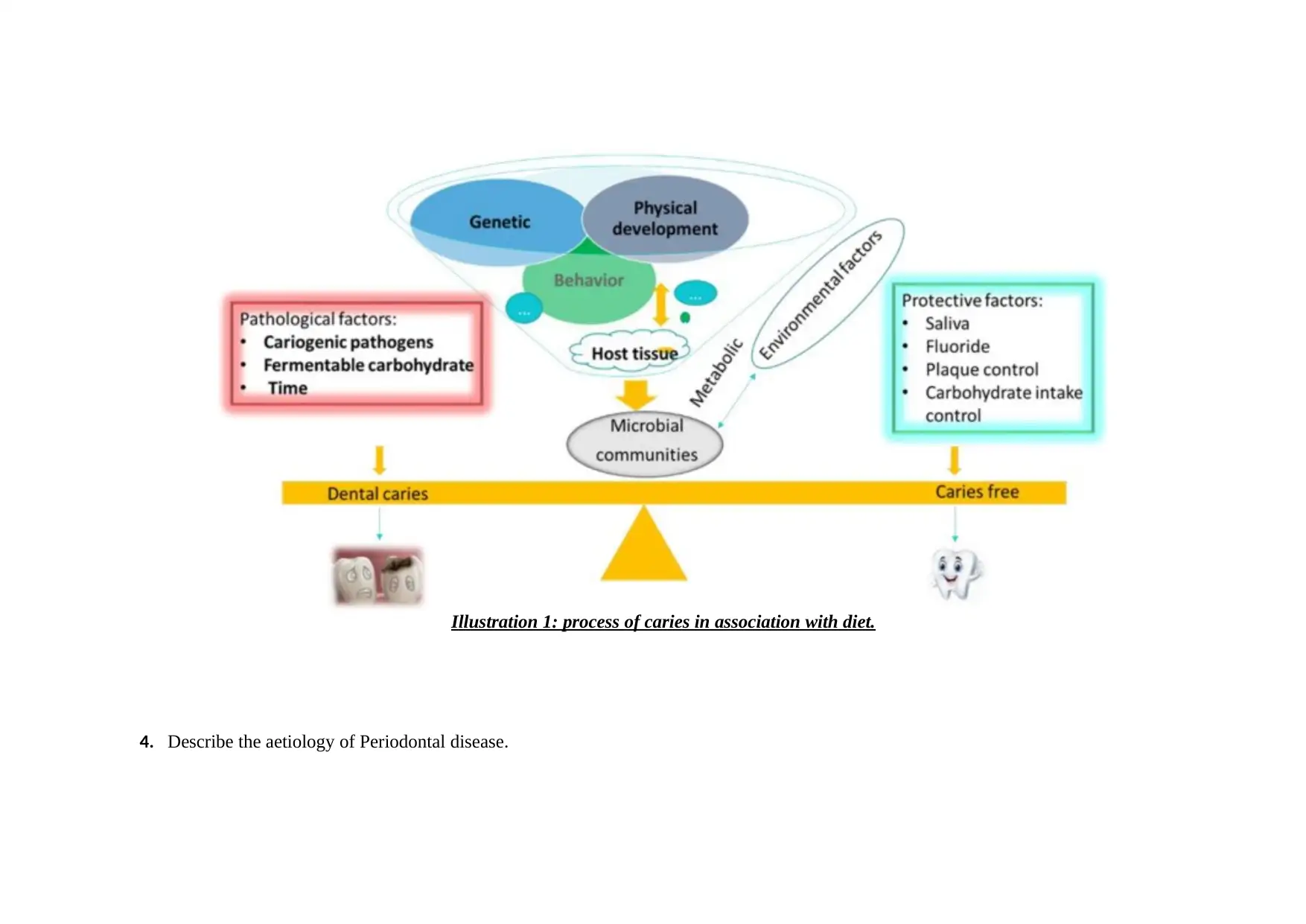
4. Describe the aetiology of Periodontal disease.
Illustration 1: process of caries in association with diet.
Illustration 1: process of caries in association with diet.
Paraphrase This Document
Need a fresh take? Get an instant paraphrase of this document with our AI Paraphraser
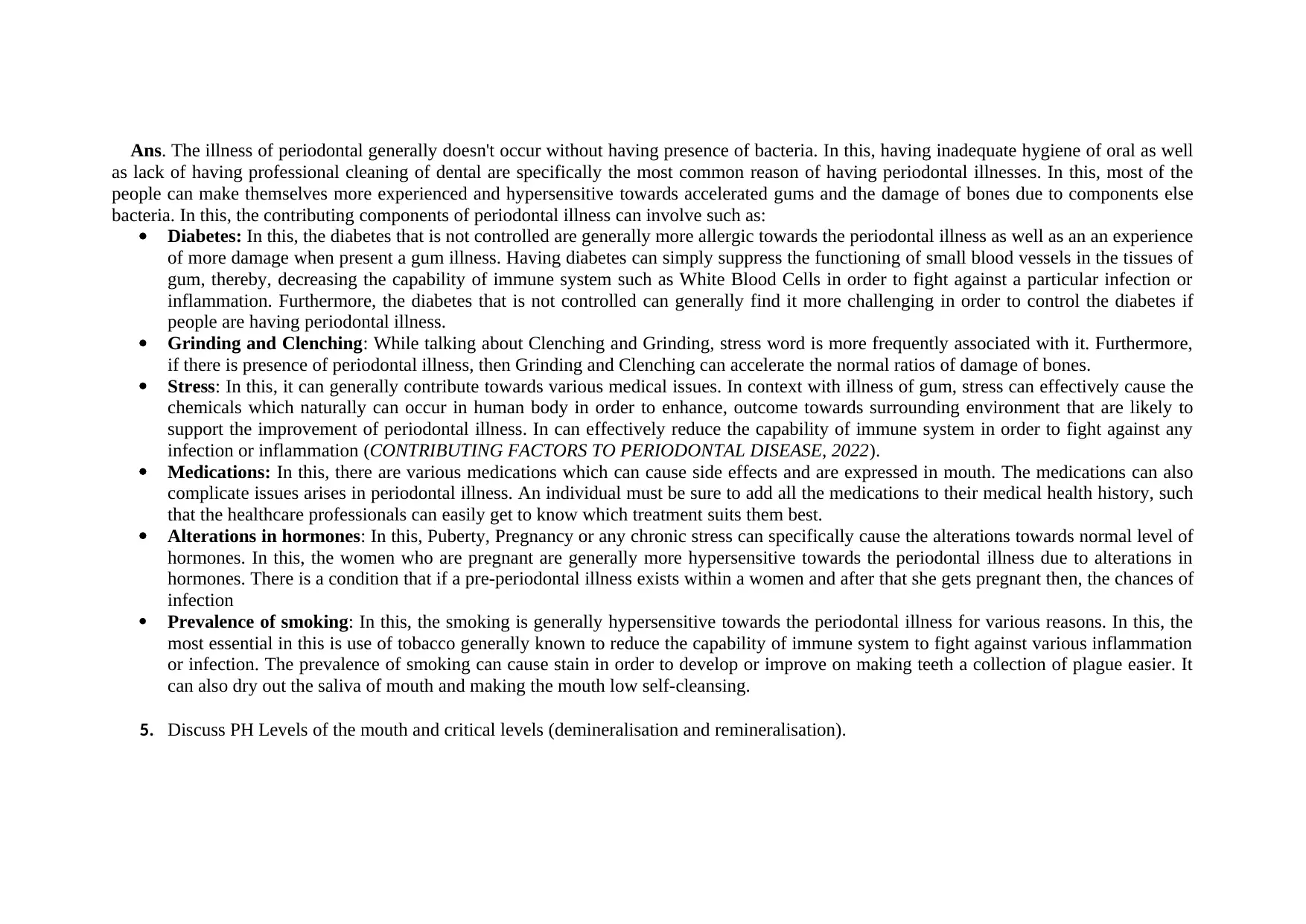
Ans. The illness of periodontal generally doesn't occur without having presence of bacteria. In this, having inadequate hygiene of oral as well
as lack of having professional cleaning of dental are specifically the most common reason of having periodontal illnesses. In this, most of the
people can make themselves more experienced and hypersensitive towards accelerated gums and the damage of bones due to components else
bacteria. In this, the contributing components of periodontal illness can involve such as:
Diabetes: In this, the diabetes that is not controlled are generally more allergic towards the periodontal illness as well as an an experience
of more damage when present a gum illness. Having diabetes can simply suppress the functioning of small blood vessels in the tissues of
gum, thereby, decreasing the capability of immune system such as White Blood Cells in order to fight against a particular infection or
inflammation. Furthermore, the diabetes that is not controlled can generally find it more challenging in order to control the diabetes if
people are having periodontal illness.
Grinding and Clenching: While talking about Clenching and Grinding, stress word is more frequently associated with it. Furthermore,
if there is presence of periodontal illness, then Grinding and Clenching can accelerate the normal ratios of damage of bones.
Stress: In this, it can generally contribute towards various medical issues. In context with illness of gum, stress can effectively cause the
chemicals which naturally can occur in human body in order to enhance, outcome towards surrounding environment that are likely to
support the improvement of periodontal illness. In can effectively reduce the capability of immune system in order to fight against any
infection or inflammation (CONTRIBUTING FACTORS TO PERIODONTAL DISEASE, 2022).
Medications: In this, there are various medications which can cause side effects and are expressed in mouth. The medications can also
complicate issues arises in periodontal illness. An individual must be sure to add all the medications to their medical health history, such
that the healthcare professionals can easily get to know which treatment suits them best.
Alterations in hormones: In this, Puberty, Pregnancy or any chronic stress can specifically cause the alterations towards normal level of
hormones. In this, the women who are pregnant are generally more hypersensitive towards the periodontal illness due to alterations in
hormones. There is a condition that if a pre-periodontal illness exists within a women and after that she gets pregnant then, the chances of
infection
Prevalence of smoking: In this, the smoking is generally hypersensitive towards the periodontal illness for various reasons. In this, the
most essential in this is use of tobacco generally known to reduce the capability of immune system to fight against various inflammation
or infection. The prevalence of smoking can cause stain in order to develop or improve on making teeth a collection of plague easier. It
can also dry out the saliva of mouth and making the mouth low self-cleansing.
5. Discuss PH Levels of the mouth and critical levels (demineralisation and remineralisation).
as lack of having professional cleaning of dental are specifically the most common reason of having periodontal illnesses. In this, most of the
people can make themselves more experienced and hypersensitive towards accelerated gums and the damage of bones due to components else
bacteria. In this, the contributing components of periodontal illness can involve such as:
Diabetes: In this, the diabetes that is not controlled are generally more allergic towards the periodontal illness as well as an an experience
of more damage when present a gum illness. Having diabetes can simply suppress the functioning of small blood vessels in the tissues of
gum, thereby, decreasing the capability of immune system such as White Blood Cells in order to fight against a particular infection or
inflammation. Furthermore, the diabetes that is not controlled can generally find it more challenging in order to control the diabetes if
people are having periodontal illness.
Grinding and Clenching: While talking about Clenching and Grinding, stress word is more frequently associated with it. Furthermore,
if there is presence of periodontal illness, then Grinding and Clenching can accelerate the normal ratios of damage of bones.
Stress: In this, it can generally contribute towards various medical issues. In context with illness of gum, stress can effectively cause the
chemicals which naturally can occur in human body in order to enhance, outcome towards surrounding environment that are likely to
support the improvement of periodontal illness. In can effectively reduce the capability of immune system in order to fight against any
infection or inflammation (CONTRIBUTING FACTORS TO PERIODONTAL DISEASE, 2022).
Medications: In this, there are various medications which can cause side effects and are expressed in mouth. The medications can also
complicate issues arises in periodontal illness. An individual must be sure to add all the medications to their medical health history, such
that the healthcare professionals can easily get to know which treatment suits them best.
Alterations in hormones: In this, Puberty, Pregnancy or any chronic stress can specifically cause the alterations towards normal level of
hormones. In this, the women who are pregnant are generally more hypersensitive towards the periodontal illness due to alterations in
hormones. There is a condition that if a pre-periodontal illness exists within a women and after that she gets pregnant then, the chances of
infection
Prevalence of smoking: In this, the smoking is generally hypersensitive towards the periodontal illness for various reasons. In this, the
most essential in this is use of tobacco generally known to reduce the capability of immune system to fight against various inflammation
or infection. The prevalence of smoking can cause stain in order to develop or improve on making teeth a collection of plague easier. It
can also dry out the saliva of mouth and making the mouth low self-cleansing.
5. Discuss PH Levels of the mouth and critical levels (demineralisation and remineralisation).

Ans. The pH level of mouth when demineralisation can occur is 5.5, generally putting them at an elevated risk for having cavities. In
this, the pH level of a healthy mouth is neutral range of pH. In this, the teeth's can become stronger as well as can remineralise when the
pH level of mouth has reach at range of 7.5 and above. Having acidity can effectively weaken the teeth's, but is generally an amount of
duration that an acid can came in contact with tooth which can identifies the range of damage occurred. Furthermore, the critical level of
pH of dental enamel is 5.5 (Geevarghese, Mathew and Mathew, 2021).
6. Describe how the natural ageing processes affect the oral cavity and surrounding tissues.
Ans. The natural ageing processes can greatly impact the oral cavity as well as its surrounding tissues such as with ageing, the taste
sensations may be destroyed. With age, people can find out that their tastes of food bland so, and for additional taste, they can add enough
amount of seasoning or they can also involve desires of hot food items that can often burn their gums. With age, people can also contain several
disorders or can take medications which can make impact in their capability to taste such as illness of gums, mouth, sinuses and nose infection,
illness of kidney, mouth cancer and so on. In older age, people who may take medications to treat their elevated pressure levels of blood, high
cholesterol levels and depression can affect their taste so badly. In this, the tooth enamel generally tends to wear away with ageing and making
the tooth more vulnerable in order to damage or destroy and can decay (Effects of Ageing on the Mouth and Teeth, 2021).
Signs and symptoms of inflammation.
Sign Symptom Treatment
Redness Headaches Medications or anti-inflammatory drugs.
Pain Fever Do adequate amount of rest.
Swelling Muscle stiffness. Keep doing the movements of joints along with muscles to strengthen
with help of physical therapy.
Heat Loss of appetite. Keep doing exercises such that muscles cannot get stiff.
Loss of function loss of energy/fatigue. Anti-inflammatory diet (Inflammation, 2020).
this, the pH level of a healthy mouth is neutral range of pH. In this, the teeth's can become stronger as well as can remineralise when the
pH level of mouth has reach at range of 7.5 and above. Having acidity can effectively weaken the teeth's, but is generally an amount of
duration that an acid can came in contact with tooth which can identifies the range of damage occurred. Furthermore, the critical level of
pH of dental enamel is 5.5 (Geevarghese, Mathew and Mathew, 2021).
6. Describe how the natural ageing processes affect the oral cavity and surrounding tissues.
Ans. The natural ageing processes can greatly impact the oral cavity as well as its surrounding tissues such as with ageing, the taste
sensations may be destroyed. With age, people can find out that their tastes of food bland so, and for additional taste, they can add enough
amount of seasoning or they can also involve desires of hot food items that can often burn their gums. With age, people can also contain several
disorders or can take medications which can make impact in their capability to taste such as illness of gums, mouth, sinuses and nose infection,
illness of kidney, mouth cancer and so on. In older age, people who may take medications to treat their elevated pressure levels of blood, high
cholesterol levels and depression can affect their taste so badly. In this, the tooth enamel generally tends to wear away with ageing and making
the tooth more vulnerable in order to damage or destroy and can decay (Effects of Ageing on the Mouth and Teeth, 2021).
Signs and symptoms of inflammation.
Sign Symptom Treatment
Redness Headaches Medications or anti-inflammatory drugs.
Pain Fever Do adequate amount of rest.
Swelling Muscle stiffness. Keep doing the movements of joints along with muscles to strengthen
with help of physical therapy.
Heat Loss of appetite. Keep doing exercises such that muscles cannot get stiff.
Loss of function loss of energy/fatigue. Anti-inflammatory diet (Inflammation, 2020).
⊘ This is a preview!⊘
Do you want full access?
Subscribe today to unlock all pages.

Trusted by 1+ million students worldwide
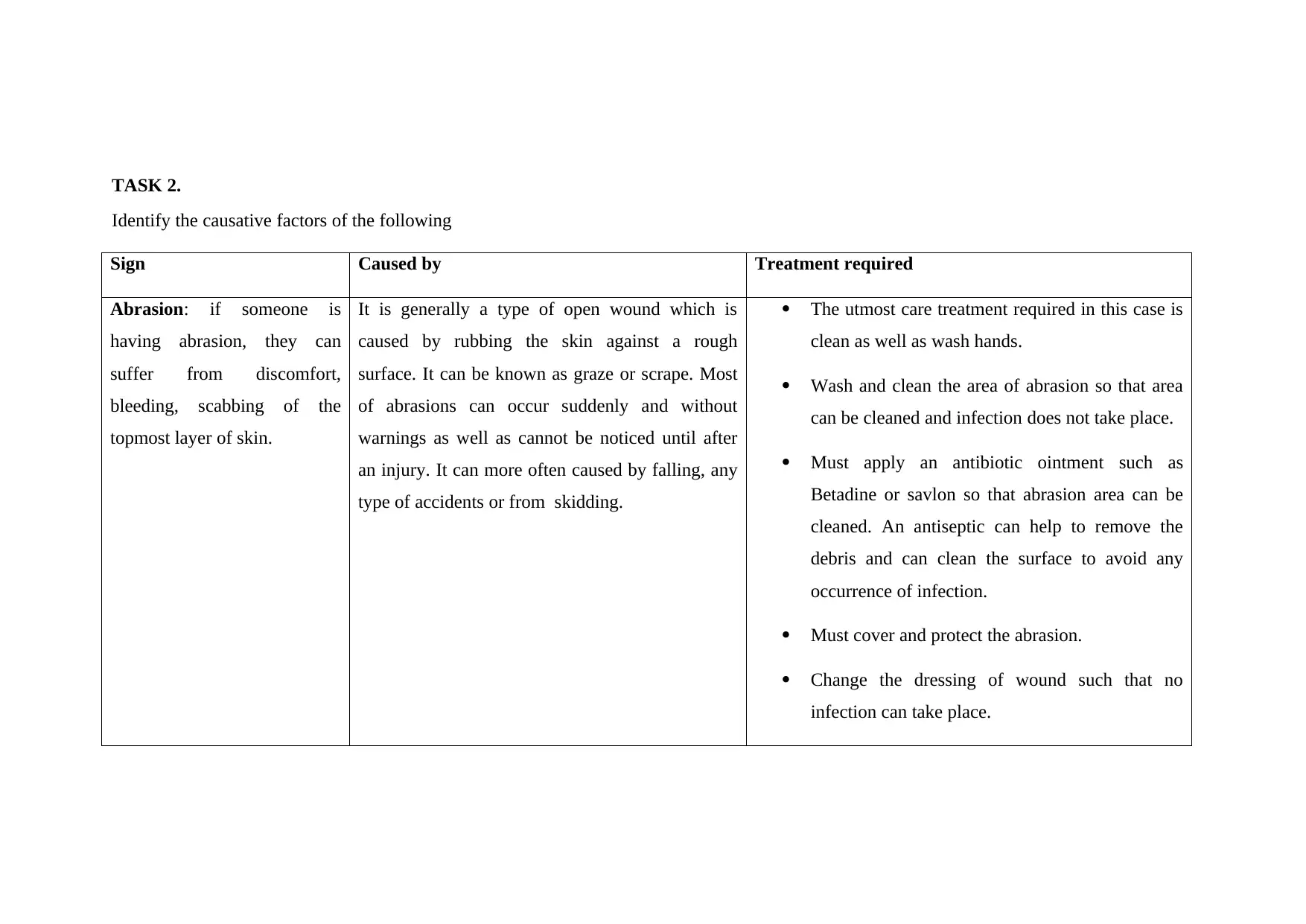
TASK 2.
Identify the causative factors of the following
Sign Caused by Treatment required
Abrasion: if someone is
having abrasion, they can
suffer from discomfort,
bleeding, scabbing of the
topmost layer of skin.
It is generally a type of open wound which is
caused by rubbing the skin against a rough
surface. It can be known as graze or scrape. Most
of abrasions can occur suddenly and without
warnings as well as cannot be noticed until after
an injury. It can more often caused by falling, any
type of accidents or from skidding.
The utmost care treatment required in this case is
clean as well as wash hands.
Wash and clean the area of abrasion so that area
can be cleaned and infection does not take place.
Must apply an antibiotic ointment such as
Betadine or savlon so that abrasion area can be
cleaned. An antiseptic can help to remove the
debris and can clean the surface to avoid any
occurrence of infection.
Must cover and protect the abrasion.
Change the dressing of wound such that no
infection can take place.
Identify the causative factors of the following
Sign Caused by Treatment required
Abrasion: if someone is
having abrasion, they can
suffer from discomfort,
bleeding, scabbing of the
topmost layer of skin.
It is generally a type of open wound which is
caused by rubbing the skin against a rough
surface. It can be known as graze or scrape. Most
of abrasions can occur suddenly and without
warnings as well as cannot be noticed until after
an injury. It can more often caused by falling, any
type of accidents or from skidding.
The utmost care treatment required in this case is
clean as well as wash hands.
Wash and clean the area of abrasion so that area
can be cleaned and infection does not take place.
Must apply an antibiotic ointment such as
Betadine or savlon so that abrasion area can be
cleaned. An antiseptic can help to remove the
debris and can clean the surface to avoid any
occurrence of infection.
Must cover and protect the abrasion.
Change the dressing of wound such that no
infection can take place.
Paraphrase This Document
Need a fresh take? Get an instant paraphrase of this document with our AI Paraphraser
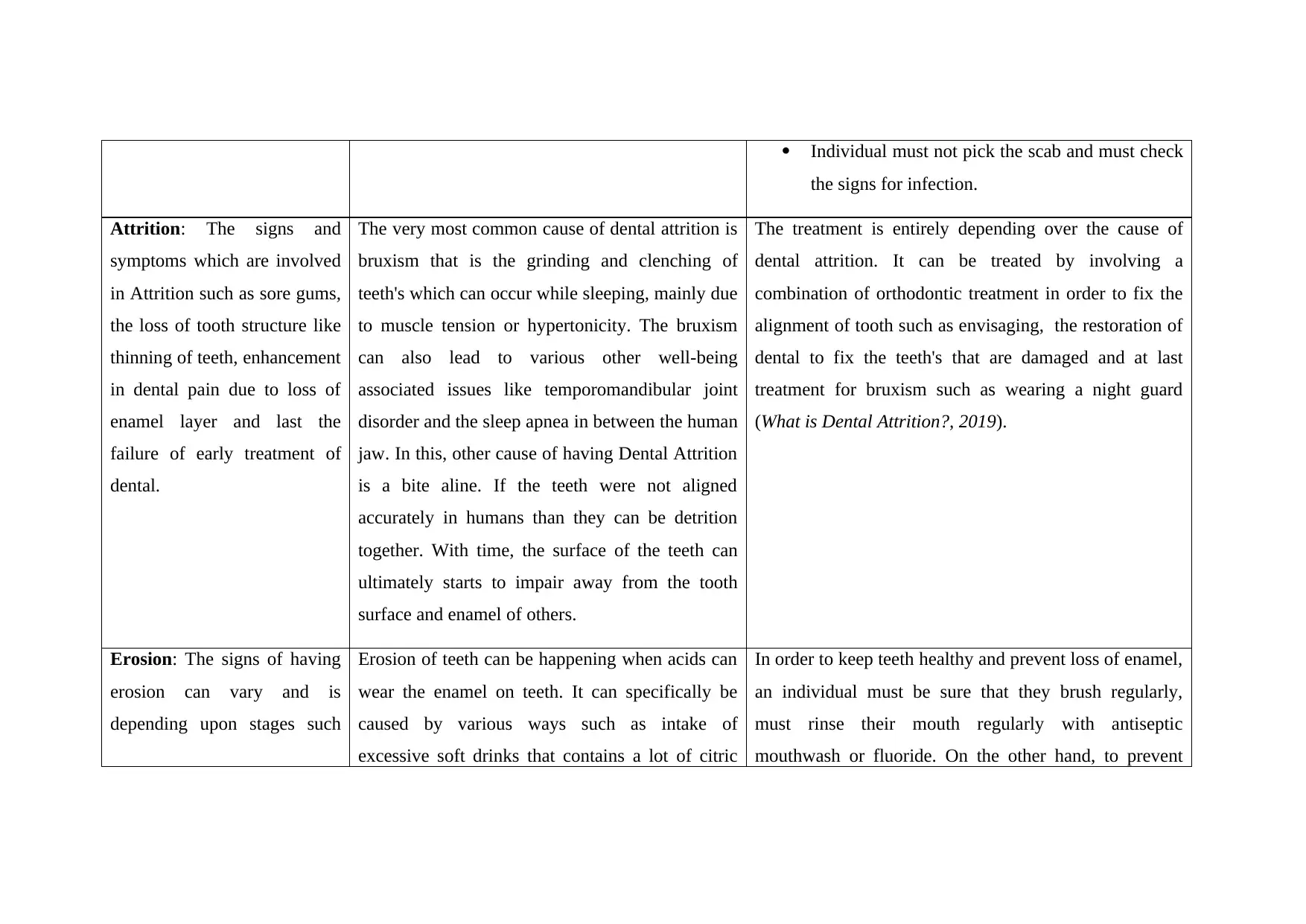
Individual must not pick the scab and must check
the signs for infection.
Attrition: The signs and
symptoms which are involved
in Attrition such as sore gums,
the loss of tooth structure like
thinning of teeth, enhancement
in dental pain due to loss of
enamel layer and last the
failure of early treatment of
dental.
The very most common cause of dental attrition is
bruxism that is the grinding and clenching of
teeth's which can occur while sleeping, mainly due
to muscle tension or hypertonicity. The bruxism
can also lead to various other well-being
associated issues like temporomandibular joint
disorder and the sleep apnea in between the human
jaw. In this, other cause of having Dental Attrition
is a bite aline. If the teeth were not aligned
accurately in humans than they can be detrition
together. With time, the surface of the teeth can
ultimately starts to impair away from the tooth
surface and enamel of others.
The treatment is entirely depending over the cause of
dental attrition. It can be treated by involving a
combination of orthodontic treatment in order to fix the
alignment of tooth such as envisaging, the restoration of
dental to fix the teeth's that are damaged and at last
treatment for bruxism such as wearing a night guard
(What is Dental Attrition?, 2019).
Erosion: The signs of having
erosion can vary and is
depending upon stages such
Erosion of teeth can be happening when acids can
wear the enamel on teeth. It can specifically be
caused by various ways such as intake of
excessive soft drinks that contains a lot of citric
In order to keep teeth healthy and prevent loss of enamel,
an individual must be sure that they brush regularly,
must rinse their mouth regularly with antiseptic
mouthwash or fluoride. On the other hand, to prevent
the signs for infection.
Attrition: The signs and
symptoms which are involved
in Attrition such as sore gums,
the loss of tooth structure like
thinning of teeth, enhancement
in dental pain due to loss of
enamel layer and last the
failure of early treatment of
dental.
The very most common cause of dental attrition is
bruxism that is the grinding and clenching of
teeth's which can occur while sleeping, mainly due
to muscle tension or hypertonicity. The bruxism
can also lead to various other well-being
associated issues like temporomandibular joint
disorder and the sleep apnea in between the human
jaw. In this, other cause of having Dental Attrition
is a bite aline. If the teeth were not aligned
accurately in humans than they can be detrition
together. With time, the surface of the teeth can
ultimately starts to impair away from the tooth
surface and enamel of others.
The treatment is entirely depending over the cause of
dental attrition. It can be treated by involving a
combination of orthodontic treatment in order to fix the
alignment of tooth such as envisaging, the restoration of
dental to fix the teeth's that are damaged and at last
treatment for bruxism such as wearing a night guard
(What is Dental Attrition?, 2019).
Erosion: The signs of having
erosion can vary and is
depending upon stages such
Erosion of teeth can be happening when acids can
wear the enamel on teeth. It can specifically be
caused by various ways such as intake of
excessive soft drinks that contains a lot of citric
In order to keep teeth healthy and prevent loss of enamel,
an individual must be sure that they brush regularly,
must rinse their mouth regularly with antiseptic
mouthwash or fluoride. On the other hand, to prevent
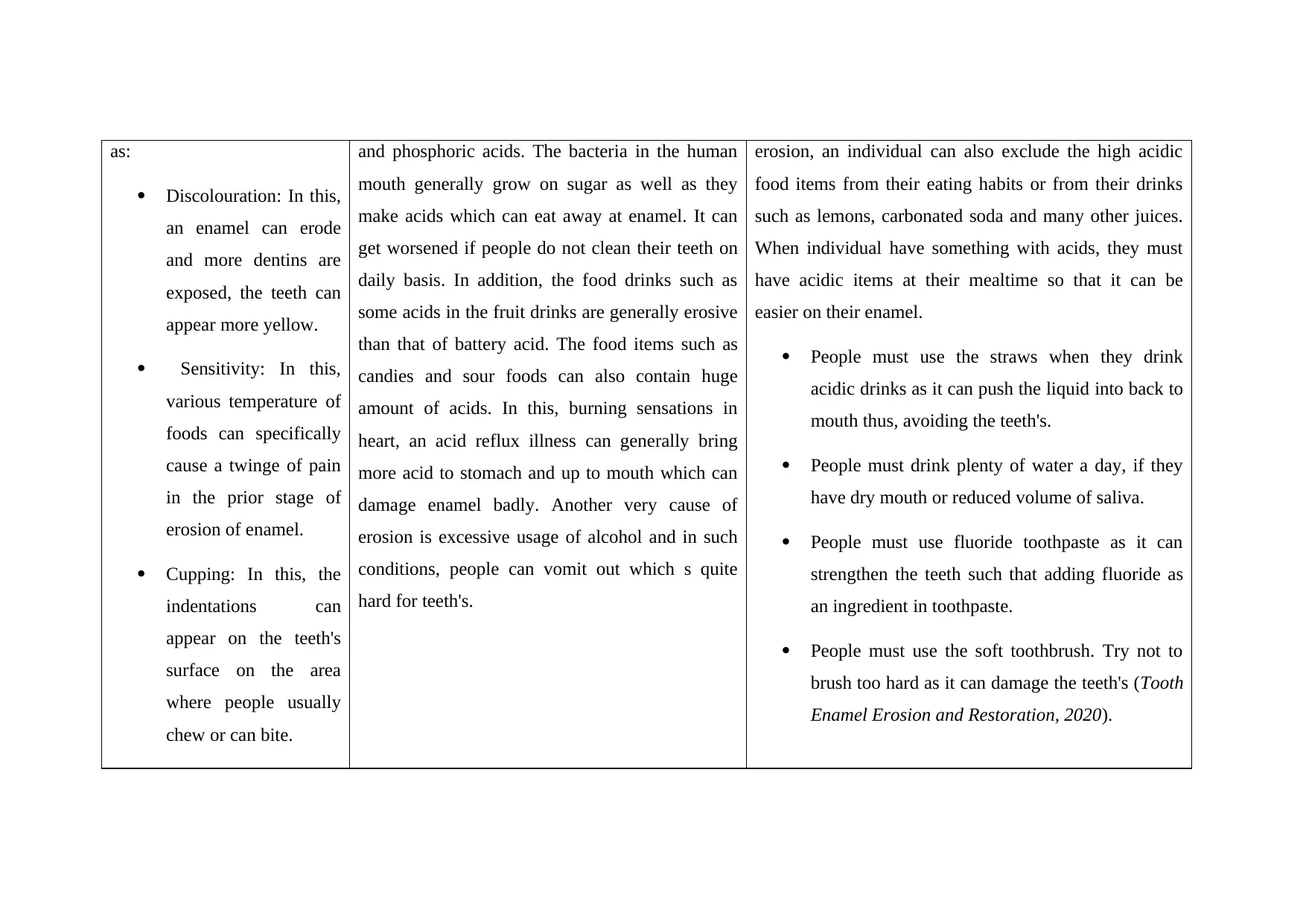
as:
Discolouration: In this,
an enamel can erode
and more dentins are
exposed, the teeth can
appear more yellow.
Sensitivity: In this,
various temperature of
foods can specifically
cause a twinge of pain
in the prior stage of
erosion of enamel.
Cupping: In this, the
indentations can
appear on the teeth's
surface on the area
where people usually
chew or can bite.
and phosphoric acids. The bacteria in the human
mouth generally grow on sugar as well as they
make acids which can eat away at enamel. It can
get worsened if people do not clean their teeth on
daily basis. In addition, the food drinks such as
some acids in the fruit drinks are generally erosive
than that of battery acid. The food items such as
candies and sour foods can also contain huge
amount of acids. In this, burning sensations in
heart, an acid reflux illness can generally bring
more acid to stomach and up to mouth which can
damage enamel badly. Another very cause of
erosion is excessive usage of alcohol and in such
conditions, people can vomit out which s quite
hard for teeth's.
erosion, an individual can also exclude the high acidic
food items from their eating habits or from their drinks
such as lemons, carbonated soda and many other juices.
When individual have something with acids, they must
have acidic items at their mealtime so that it can be
easier on their enamel.
People must use the straws when they drink
acidic drinks as it can push the liquid into back to
mouth thus, avoiding the teeth's.
People must drink plenty of water a day, if they
have dry mouth or reduced volume of saliva.
People must use fluoride toothpaste as it can
strengthen the teeth such that adding fluoride as
an ingredient in toothpaste.
People must use the soft toothbrush. Try not to
brush too hard as it can damage the teeth's (Tooth
Enamel Erosion and Restoration, 2020).
Discolouration: In this,
an enamel can erode
and more dentins are
exposed, the teeth can
appear more yellow.
Sensitivity: In this,
various temperature of
foods can specifically
cause a twinge of pain
in the prior stage of
erosion of enamel.
Cupping: In this, the
indentations can
appear on the teeth's
surface on the area
where people usually
chew or can bite.
and phosphoric acids. The bacteria in the human
mouth generally grow on sugar as well as they
make acids which can eat away at enamel. It can
get worsened if people do not clean their teeth on
daily basis. In addition, the food drinks such as
some acids in the fruit drinks are generally erosive
than that of battery acid. The food items such as
candies and sour foods can also contain huge
amount of acids. In this, burning sensations in
heart, an acid reflux illness can generally bring
more acid to stomach and up to mouth which can
damage enamel badly. Another very cause of
erosion is excessive usage of alcohol and in such
conditions, people can vomit out which s quite
hard for teeth's.
erosion, an individual can also exclude the high acidic
food items from their eating habits or from their drinks
such as lemons, carbonated soda and many other juices.
When individual have something with acids, they must
have acidic items at their mealtime so that it can be
easier on their enamel.
People must use the straws when they drink
acidic drinks as it can push the liquid into back to
mouth thus, avoiding the teeth's.
People must drink plenty of water a day, if they
have dry mouth or reduced volume of saliva.
People must use fluoride toothpaste as it can
strengthen the teeth such that adding fluoride as
an ingredient in toothpaste.
People must use the soft toothbrush. Try not to
brush too hard as it can damage the teeth's (Tooth
Enamel Erosion and Restoration, 2020).
⊘ This is a preview!⊘
Do you want full access?
Subscribe today to unlock all pages.

Trusted by 1+ million students worldwide
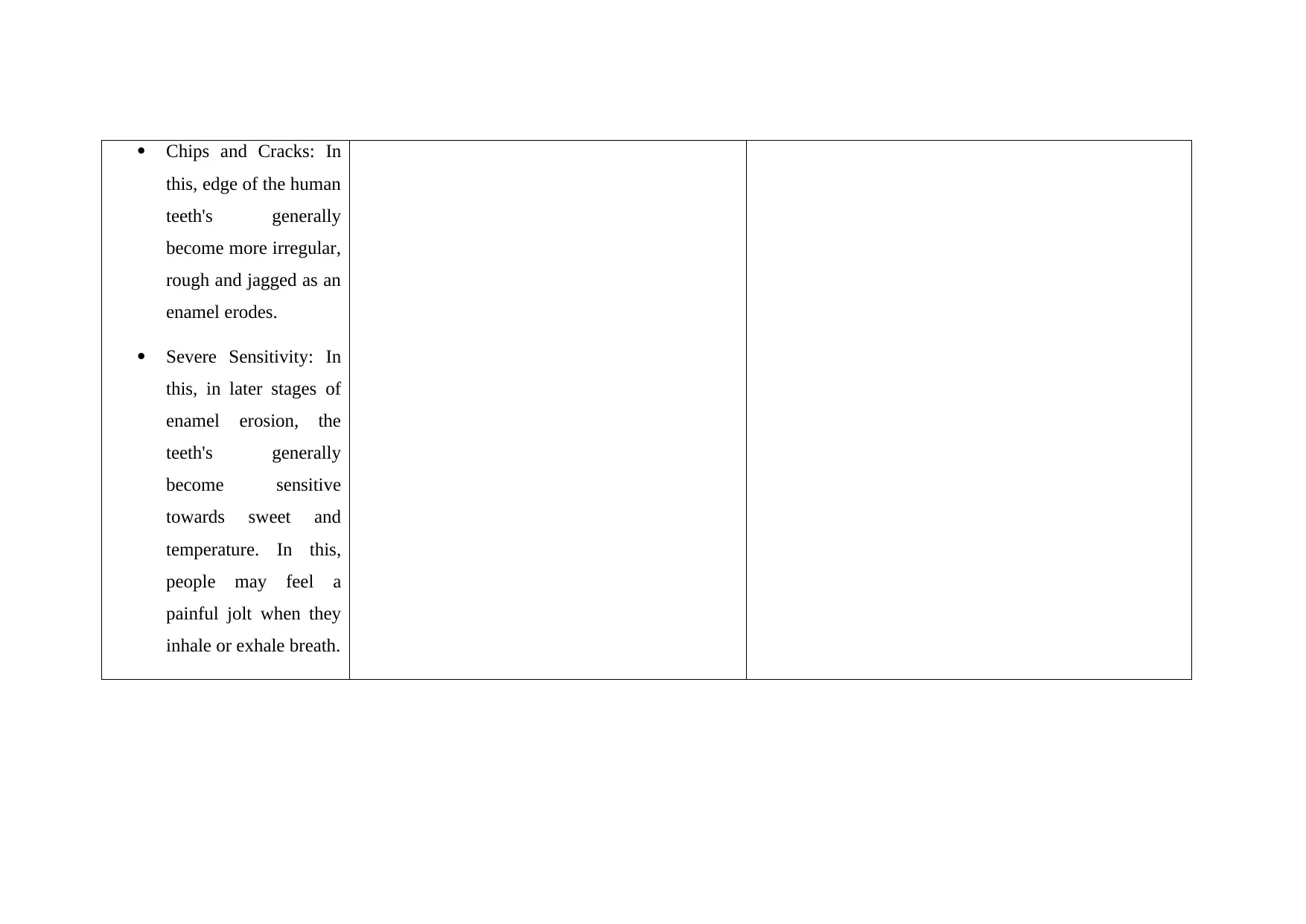
Chips and Cracks: In
this, edge of the human
teeth's generally
become more irregular,
rough and jagged as an
enamel erodes.
Severe Sensitivity: In
this, in later stages of
enamel erosion, the
teeth's generally
become sensitive
towards sweet and
temperature. In this,
people may feel a
painful jolt when they
inhale or exhale breath.
this, edge of the human
teeth's generally
become more irregular,
rough and jagged as an
enamel erodes.
Severe Sensitivity: In
this, in later stages of
enamel erosion, the
teeth's generally
become sensitive
towards sweet and
temperature. In this,
people may feel a
painful jolt when they
inhale or exhale breath.
Paraphrase This Document
Need a fresh take? Get an instant paraphrase of this document with our AI Paraphraser
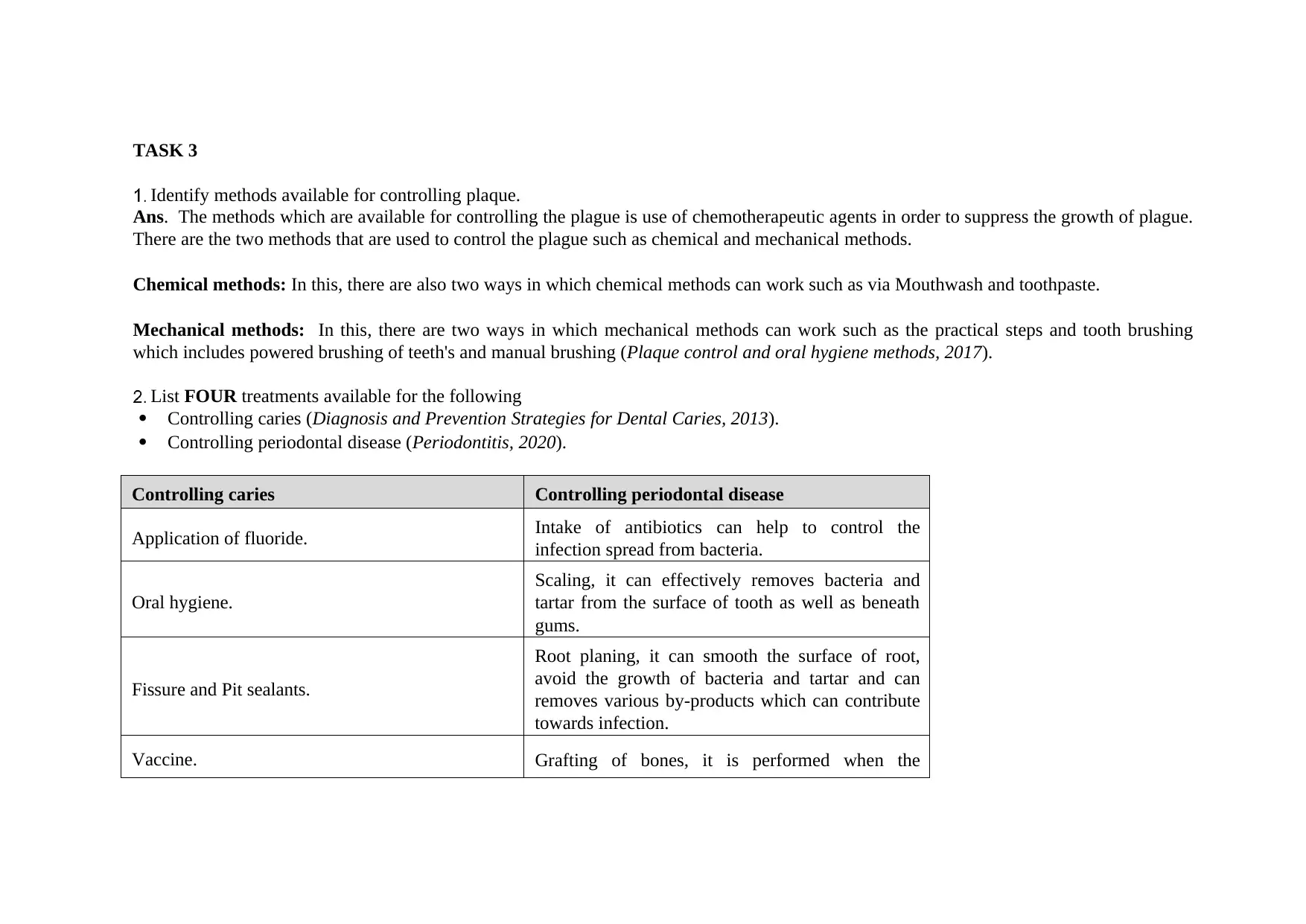
TASK 3
Identify methods available for controlling plaque.
Ans. The methods which are available for controlling the plague is use of chemotherapeutic agents in order to suppress the growth of plague.
There are the two methods that are used to control the plague such as chemical and mechanical methods.
Chemical methods: In this, there are also two ways in which chemical methods can work such as via Mouthwash and toothpaste.
Mechanical methods: In this, there are two ways in which mechanical methods can work such as the practical steps and tooth brushing
which includes powered brushing of teeth's and manual brushing (Plaque control and oral hygiene methods, 2017).
List FOUR treatments available for the following
Controlling caries (Diagnosis and Prevention Strategies for Dental Caries, 2013).
Controlling periodontal disease (Periodontitis, 2020).
Controlling caries Controlling periodontal disease
Application of fluoride. Intake of antibiotics can help to control the
infection spread from bacteria.
Oral hygiene.
Scaling, it can effectively removes bacteria and
tartar from the surface of tooth as well as beneath
gums.
Fissure and Pit sealants.
Root planing, it can smooth the surface of root,
avoid the growth of bacteria and tartar and can
removes various by-products which can contribute
towards infection.
Vaccine. Grafting of bones, it is performed when the
Identify methods available for controlling plaque.
Ans. The methods which are available for controlling the plague is use of chemotherapeutic agents in order to suppress the growth of plague.
There are the two methods that are used to control the plague such as chemical and mechanical methods.
Chemical methods: In this, there are also two ways in which chemical methods can work such as via Mouthwash and toothpaste.
Mechanical methods: In this, there are two ways in which mechanical methods can work such as the practical steps and tooth brushing
which includes powered brushing of teeth's and manual brushing (Plaque control and oral hygiene methods, 2017).
List FOUR treatments available for the following
Controlling caries (Diagnosis and Prevention Strategies for Dental Caries, 2013).
Controlling periodontal disease (Periodontitis, 2020).
Controlling caries Controlling periodontal disease
Application of fluoride. Intake of antibiotics can help to control the
infection spread from bacteria.
Oral hygiene.
Scaling, it can effectively removes bacteria and
tartar from the surface of tooth as well as beneath
gums.
Fissure and Pit sealants.
Root planing, it can smooth the surface of root,
avoid the growth of bacteria and tartar and can
removes various by-products which can contribute
towards infection.
Vaccine. Grafting of bones, it is performed when the

periodontitis has fully destroyed the bone around
roots of teeth's.
roots of teeth's.
⊘ This is a preview!⊘
Do you want full access?
Subscribe today to unlock all pages.

Trusted by 1+ million students worldwide
1 out of 17
Related Documents
Your All-in-One AI-Powered Toolkit for Academic Success.
+13062052269
info@desklib.com
Available 24*7 on WhatsApp / Email
![[object Object]](/_next/static/media/star-bottom.7253800d.svg)
Unlock your academic potential
Copyright © 2020–2025 A2Z Services. All Rights Reserved. Developed and managed by ZUCOL.




